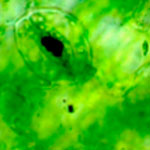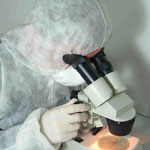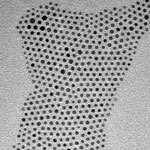Showing Spotlights 153 - 160 of 217 in category All (newest first):
 It started innocently enough with isolated instances of smoke coming out of computers. Then networks crashed. Now, programs are malfunctioning on a large scale, shutting down the Vatican's huge computer infrastructure which it depends on to manage its billions upon billions of investment dollars, real estate portfolios, and art collections. It is difficult to obtain all the details, but it appears that some form of nanotechnology got out of control. Surprisingly, and against its deeply ingrained reflexes of total openness and transparency, the Vatican initially tried to cover the whole thing up. Until a tabloid reporter got wind of what had happened and the whole thing became public with an article today (April 1) in an Italian tabloid that had this sensation-seeking headline splashed all over the front page: "Gay nanobots ballano Bunga-Bunga in Vaticano" - Gay nanobots dance Bunga-Bunga in the Vatican.
It started innocently enough with isolated instances of smoke coming out of computers. Then networks crashed. Now, programs are malfunctioning on a large scale, shutting down the Vatican's huge computer infrastructure which it depends on to manage its billions upon billions of investment dollars, real estate portfolios, and art collections. It is difficult to obtain all the details, but it appears that some form of nanotechnology got out of control. Surprisingly, and against its deeply ingrained reflexes of total openness and transparency, the Vatican initially tried to cover the whole thing up. Until a tabloid reporter got wind of what had happened and the whole thing became public with an article today (April 1) in an Italian tabloid that had this sensation-seeking headline splashed all over the front page: "Gay nanobots ballano Bunga-Bunga in Vaticano" - Gay nanobots dance Bunga-Bunga in the Vatican.
Apr 1st, 2011
 At the core of research efforts to determine the impact of synthetic nanoparticles on the environment and living systems is a fundamental understanding of the interactions between man-made nanoparticles and natural living systems that have evolved over millions of years. To describe nanoparticles at large, it may be beneficial to acknowledge that 1) biological systems are part of the food chain and therefore an essential component of the ecosystems and 2) collaborations are essential for such interdisciplinary research. Researchers have now presented a biophysical perspective that describes the fate of nanoparticles in both the aqueous phase and in living systems.
At the core of research efforts to determine the impact of synthetic nanoparticles on the environment and living systems is a fundamental understanding of the interactions between man-made nanoparticles and natural living systems that have evolved over millions of years. To describe nanoparticles at large, it may be beneficial to acknowledge that 1) biological systems are part of the food chain and therefore an essential component of the ecosystems and 2) collaborations are essential for such interdisciplinary research. Researchers have now presented a biophysical perspective that describes the fate of nanoparticles in both the aqueous phase and in living systems.
Mar 16th, 2011
 One of the main basic bacterial survival strategies is the colonization of a surface and the consequent growth as biofilm community, which is embedded in a gel-like polysaccharide matrix. In spite of its swimming/planktonic counterpart, such sessile adherent bacterial population represents an excellent life-support system. A biofilm like bacteria community is in fact highly resistant to almost any classical bactericidal and bacteriostatic tools, ranging from broad-spectrum antibiotics to UV-rays, disinfectant, heat, and so on. Thus, the design of biomaterials with active antibacterial and self-cleaning properties represents a good opportunity for solving the biofilm associated infections. One of the main goal is avoiding one of the first necessary steps required for the biofilm growth, namely the bacterial adhesion onto the target surface.
One of the main basic bacterial survival strategies is the colonization of a surface and the consequent growth as biofilm community, which is embedded in a gel-like polysaccharide matrix. In spite of its swimming/planktonic counterpart, such sessile adherent bacterial population represents an excellent life-support system. A biofilm like bacteria community is in fact highly resistant to almost any classical bactericidal and bacteriostatic tools, ranging from broad-spectrum antibiotics to UV-rays, disinfectant, heat, and so on. Thus, the design of biomaterials with active antibacterial and self-cleaning properties represents a good opportunity for solving the biofilm associated infections. One of the main goal is avoiding one of the first necessary steps required for the biofilm growth, namely the bacterial adhesion onto the target surface.
Mar 8th, 2011
 There is a need for the larger nanotechnology community synthesizing, applying or characterizing nanomaterials to have a methodology to evaluate the risk and to apply adequate protection measures to limit human exposure. Researchers in Switzerland have now taken the initiative and presented a practical, user-friendly procedure for a university-wide safety and health management of nanomaterials, developed as a multi-stakeholder effort (government, accident insurance, researchers and experts for occupational safety and health). The procedure consists of two parts: Using a decision tree, nano-labs are sorted into three hazard classes, which corresponds to analogue approaches applied to other hazard types (biohazard, radioprotection or chemistry). A list of required prevention/protection measures (safety barriers) for each hazard level is then provided.
There is a need for the larger nanotechnology community synthesizing, applying or characterizing nanomaterials to have a methodology to evaluate the risk and to apply adequate protection measures to limit human exposure. Researchers in Switzerland have now taken the initiative and presented a practical, user-friendly procedure for a university-wide safety and health management of nanomaterials, developed as a multi-stakeholder effort (government, accident insurance, researchers and experts for occupational safety and health). The procedure consists of two parts: Using a decision tree, nano-labs are sorted into three hazard classes, which corresponds to analogue approaches applied to other hazard types (biohazard, radioprotection or chemistry). A list of required prevention/protection measures (safety barriers) for each hazard level is then provided.
Feb 14th, 2011
 Their use in large-scale commercial applications requires cobalt nanoparticles with well-defined size and shape to be prepared in large quantities. Accurate tuning of the nanoparticle size and shape requires understanding of the mechanisms involved in particle nucleation and growth. In spite of extensive ongoing research, these mechanisms are still not fully understood owing to their complexity and interplay. Moreover, the current small-scale synthesis methods, such as the hot-injection method, can be difficult to scale to industrially relevant levels. In order to find more suitable methods for synthesizing cobalt nanoparticles, Finnish researchers revisited a widely studied hot-injection synthesis of monodisperse cobalt nanoparticles and show that the particle nucleation differs from what is expected for a hot-injection synthesis.
Their use in large-scale commercial applications requires cobalt nanoparticles with well-defined size and shape to be prepared in large quantities. Accurate tuning of the nanoparticle size and shape requires understanding of the mechanisms involved in particle nucleation and growth. In spite of extensive ongoing research, these mechanisms are still not fully understood owing to their complexity and interplay. Moreover, the current small-scale synthesis methods, such as the hot-injection method, can be difficult to scale to industrially relevant levels. In order to find more suitable methods for synthesizing cobalt nanoparticles, Finnish researchers revisited a widely studied hot-injection synthesis of monodisperse cobalt nanoparticles and show that the particle nucleation differs from what is expected for a hot-injection synthesis.
Feb 9th, 2011
 A caustic is the envelope of light rays reflected or refracted by a curved surface or object, or the projection of that envelope of rays on another surface. A familiar example of optical caustics is the bright line seen in a coffee cup on a bright sunny day. Here the caustic is formed by the envelope of the light rays reflected by the curved surface of the coffee cup. Caustics are formed in an anisotropic media because the direction of the group velocity and the phase velocity or the wave vector does not coincide. New theoretical work shows the existence of spin wave caustics in nanoscale ferrites, ferromagnetic and antiferromagnetic materials. Based on their theoretical results, the researchers have proposed a new device called a high frequency 'router'.
A caustic is the envelope of light rays reflected or refracted by a curved surface or object, or the projection of that envelope of rays on another surface. A familiar example of optical caustics is the bright line seen in a coffee cup on a bright sunny day. Here the caustic is formed by the envelope of the light rays reflected by the curved surface of the coffee cup. Caustics are formed in an anisotropic media because the direction of the group velocity and the phase velocity or the wave vector does not coincide. New theoretical work shows the existence of spin wave caustics in nanoscale ferrites, ferromagnetic and antiferromagnetic materials. Based on their theoretical results, the researchers have proposed a new device called a high frequency 'router'.
Jan 31st, 2011
 Patterns of news coverage on nanotechnology are developing in ways that mirror issue cycles for previous technologies, including agricultural biotechnology. In particular, early coverage of nanotechnology was dominated by a general optimism about the scientific potential and economic impacts of this new technology. This is in part related to the fact that a sizeable proportion of nanotechnology news coverage - at least in newspapers - continues to be provided by a handful of science journalists and business writers. This is an initial draft of an article that what will eventually become a chapter on public attitudes toward nanotechnology in a new book on risk communication and public perception of nanotechnology. It's meant to be a current update and comprehensive overview of what we know (and don't know) at this point.
Patterns of news coverage on nanotechnology are developing in ways that mirror issue cycles for previous technologies, including agricultural biotechnology. In particular, early coverage of nanotechnology was dominated by a general optimism about the scientific potential and economic impacts of this new technology. This is in part related to the fact that a sizeable proportion of nanotechnology news coverage - at least in newspapers - continues to be provided by a handful of science journalists and business writers. This is an initial draft of an article that what will eventually become a chapter on public attitudes toward nanotechnology in a new book on risk communication and public perception of nanotechnology. It's meant to be a current update and comprehensive overview of what we know (and don't know) at this point.
Jan 24th, 2011
 At the nanoscale, the properties of materials - mechanical, electrical, thermal, optical - often differ significantly from their bulk behavior. And while nanostructured and nanoengineered products are appearing in the marketplace, researchers are still trying to understand all aspects of materials properties of nanostructures and how they can be modified and controlled. Vacancies (also called Schottky defect) play a major role in the electrical and thermal transport as well as the mechanical behavior of materials. A vacancy is the simplest defect which can be created in a material - it corresponds to a lack of an atom in the lattice. New theoretical work calculates the size effect on the vacancy formation energy, the vacancy formation entropy and the vacancy concentration into nanomaterials through a top-down approach by using classical thermodynamics.
At the nanoscale, the properties of materials - mechanical, electrical, thermal, optical - often differ significantly from their bulk behavior. And while nanostructured and nanoengineered products are appearing in the marketplace, researchers are still trying to understand all aspects of materials properties of nanostructures and how they can be modified and controlled. Vacancies (also called Schottky defect) play a major role in the electrical and thermal transport as well as the mechanical behavior of materials. A vacancy is the simplest defect which can be created in a material - it corresponds to a lack of an atom in the lattice. New theoretical work calculates the size effect on the vacancy formation energy, the vacancy formation entropy and the vacancy concentration into nanomaterials through a top-down approach by using classical thermodynamics.
Jan 18th, 2011
 It started innocently enough with isolated instances of smoke coming out of computers. Then networks crashed. Now, programs are malfunctioning on a large scale, shutting down the Vatican's huge computer infrastructure which it depends on to manage its billions upon billions of investment dollars, real estate portfolios, and art collections. It is difficult to obtain all the details, but it appears that some form of nanotechnology got out of control. Surprisingly, and against its deeply ingrained reflexes of total openness and transparency, the Vatican initially tried to cover the whole thing up. Until a tabloid reporter got wind of what had happened and the whole thing became public with an article today (April 1) in an Italian tabloid that had this sensation-seeking headline splashed all over the front page: "Gay nanobots ballano Bunga-Bunga in Vaticano" - Gay nanobots dance Bunga-Bunga in the Vatican.
It started innocently enough with isolated instances of smoke coming out of computers. Then networks crashed. Now, programs are malfunctioning on a large scale, shutting down the Vatican's huge computer infrastructure which it depends on to manage its billions upon billions of investment dollars, real estate portfolios, and art collections. It is difficult to obtain all the details, but it appears that some form of nanotechnology got out of control. Surprisingly, and against its deeply ingrained reflexes of total openness and transparency, the Vatican initially tried to cover the whole thing up. Until a tabloid reporter got wind of what had happened and the whole thing became public with an article today (April 1) in an Italian tabloid that had this sensation-seeking headline splashed all over the front page: "Gay nanobots ballano Bunga-Bunga in Vaticano" - Gay nanobots dance Bunga-Bunga in the Vatican.
 Subscribe to our Nanotechnology Spotlight feed
Subscribe to our Nanotechnology Spotlight feed





